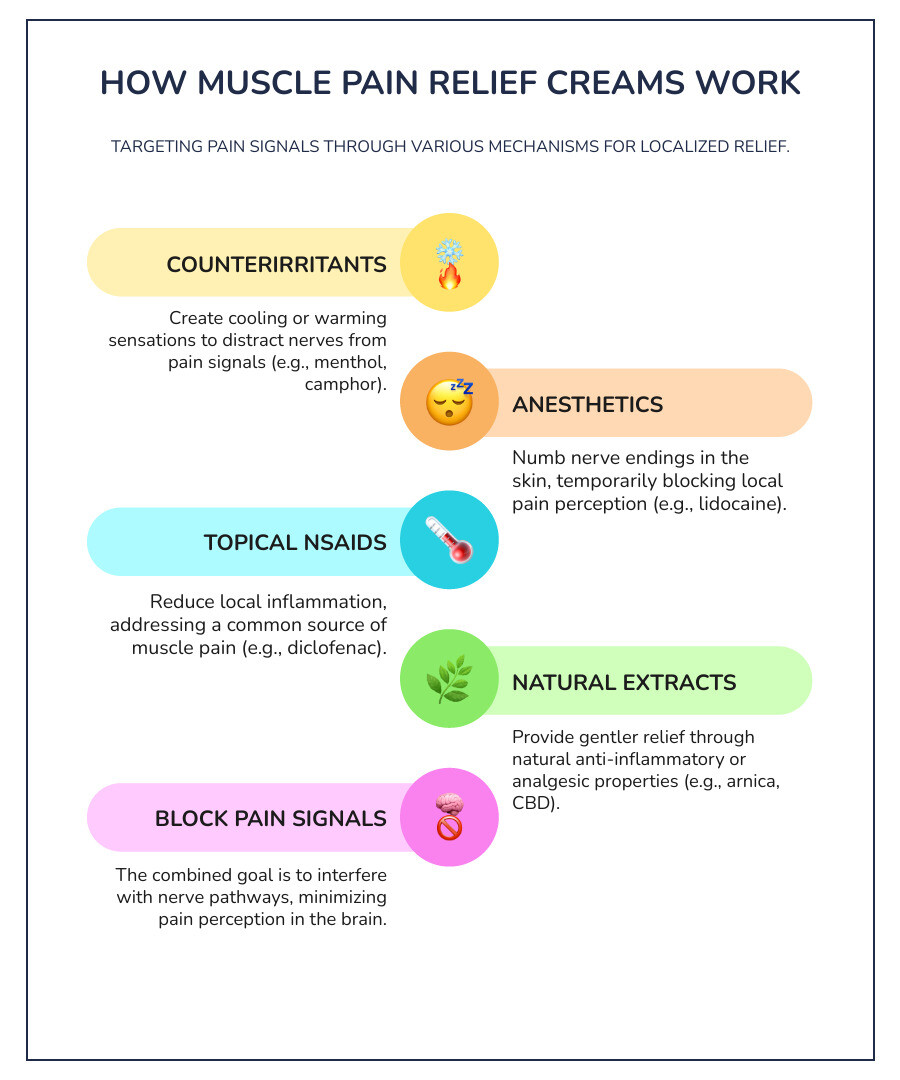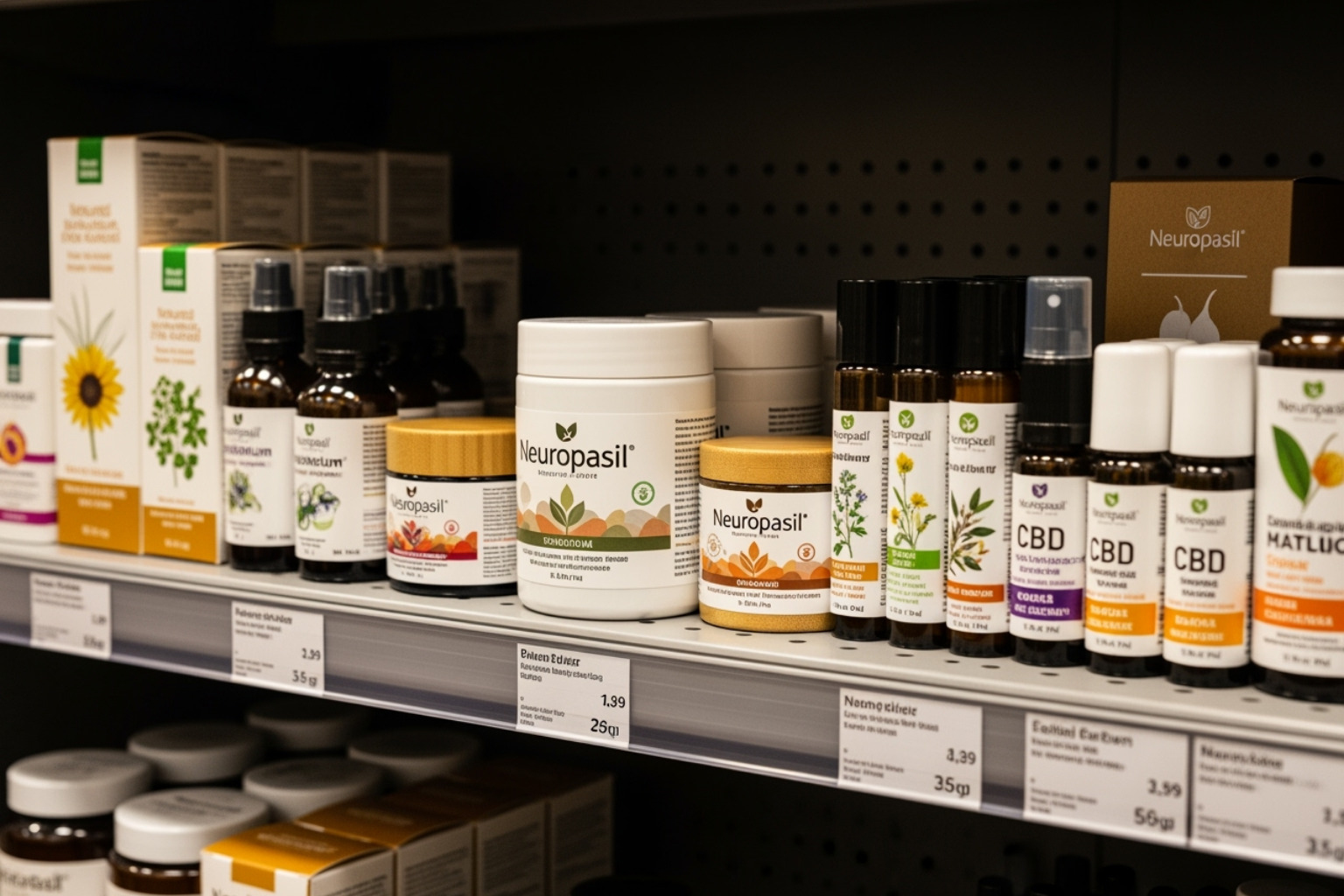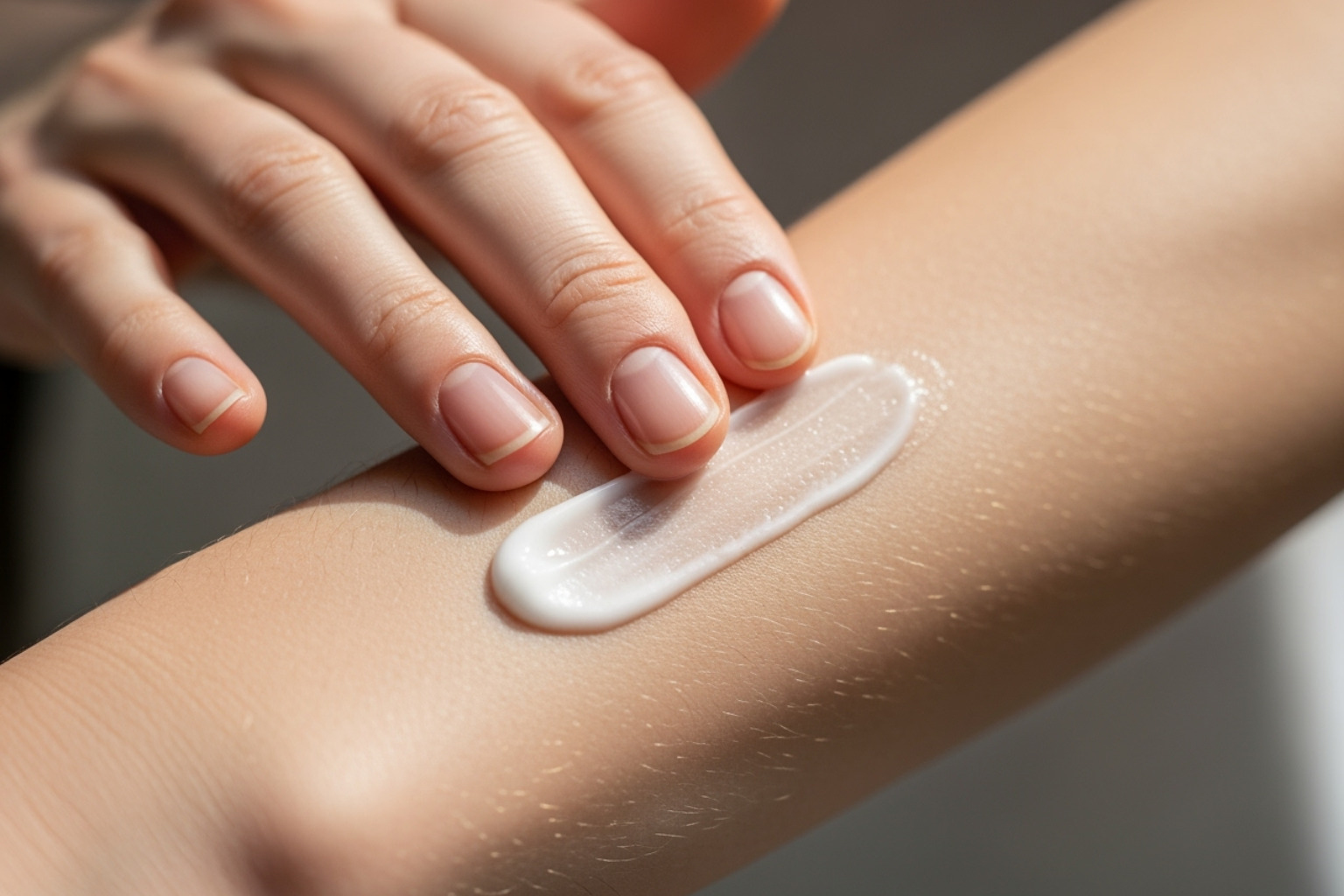Introduction: Your First Aid for Aching Muscles
Pain relief cream muscle products offer fast, localized relief by blocking pain signals with active ingredients, avoiding the systemic side effects of oral medications. Here's a quick overview:
Key Types of Muscle Pain Relief Creams:
- Counterirritants (menthol, camphor): Create cooling/warming sensations to distract from pain.
- Anesthetics (lidocaine): Numb nerve endings for temporary relief.
- NSAIDs (diclofenac): Reduce inflammation at the source.
- Natural ingredients (arnica, turmeric, CBD): Provide gentler, plant-based relief.
Quick Application Guide:
- Apply a thin layer to clean, dry skin.
- Massage gently until absorbed.
- Use 3-4 times daily as needed.
- Wash hands after application.
- Avoid broken skin and eyes.
From post-workout soreness to a stiff neck from desk work, muscle discomfort can disrupt daily life. While rest and nutrition are key for recovery, topical analgesics help manage the perception of soreness. These creams interfere with the neural pathways that transmit pain signals to the brain. As research from Cleveland Clinic notes, ingredients like capsaicin create sensations that block these signals.
The market is vast, with options ranging from high-menthol formulas for athletes to natural, plant-based solutions with arnica and turmeric. Some creams contain NSAIDs like diclofenac to target inflammation directly.
I'm Tony Enrico, and at Neuropasil, I've focused on helping people manage pain naturally. Our formulas use menthol, aloe, urea, and panthenol to provide fast, long-lasting relief without harsh chemicals or greasy residue. My expertise in pain relief cream muscle solutions comes from years of developing effective, gentle products.

How Do Muscle Pain Relief Creams Work? The Science of Soothing
When muscles send out distress signals, many of us reach for a pain relief cream muscle product. But how do they work? The science is clever and targeted.
The core principle is localized relief. Unlike oral medications that travel through your bloodstream, topical creams deliver active ingredients precisely to the affected area. This means you get relief right where you need it, often minimizing the systemic side effects that oral pills might cause.
The main mechanism involves blocking pain signals. Our bodies have an intricate nerve communication system, and pain occurs when signals travel to the brain. Topical analgesics interfere with these pathways. For example, menthol creates a strong cooling sensation that distracts your brain from the pain. As Dr. Brad Whitley, PT, DPT, XPS, points out, these topicals don't directly help with muscle recovery but instead minimize our perception of soreness. This targeted approach is a great advantage over oral pain relievers, which can carry risks like stomach upset or liver issues. If you're curious to dive deeper into understanding muscle pain, you can find more info about Muscle Pain here.
Here's a quick comparison:
| Feature | Topical Creams | Oral Painkillers |
|---|---|---|
| Target Area | Localized, directly on the painful spot | Systemic, affects the whole body |
| Speed of Relief | Often fast-acting due to direct application | Varies, usually takes longer to kick in |
| Side Effects | Primarily local (skin irritation), fewer systemic | Can cause stomach upset, liver issues, drowsiness, etc. |
| Use Case | Targeted muscle aches, strains, joint discomfort | Widespread pain, fevers, inflammation |
Understanding the Key Active Ingredients
The effectiveness of any pain relief cream muscle product lies in its active ingredients. Each has a unique way of tackling pain:
-
Counterirritants: These create a sensation like warmth or coolness on your skin to distract your nervous system from the actual pain.
- Menthol: A classic in pain relief, menthol provides a powerful cooling sensation. Our Neuropasil creams harness menthol to deliver that immediate, soothing cool.
- Camphor: Similar to menthol, camphor creates a warming or cooling feeling.
- Capsaicin: This compound from chili peppers makes your skin feel warm, which helps block pain signals. The Cleveland Clinic highlights how capsaicin works by creating these sensations. Avoid hot baths or heating pads after applying capsaicin products.
-
Salicylates: Related to aspirin, these ingredients help reduce inflammation and pain.
- Methyl salicylate: Often paired with menthol, this topical analgesic helps soothe aches.
-
Anesthetics: These ingredients temporarily numb nerve endings.
- Lidocaine: A local anesthetic, lidocaine gently numbs nerves for temporary relief from localized soreness. See MedlinePlus: Lidocaine topical.
-
NSAIDs (Non-Steroidal Anti-Inflammatory Drugs): These are powerful agents that reduce both pain and swelling.
- Diclofenac: This NSAID penetrates the skin to provide local relief from pain and inflammation by reducing prostaglandins, chemicals that cause pain and inflammation. See MedlinePlus: Diclofenac topical gel.
-
Natural Ingredients: For a gentler, plant-based approach, several natural ingredients offer pain-relieving properties.
- Arnica: A popular homeopathic remedy used for bruising and muscle soreness.
- Turmeric: Famous for its anti-inflammatory powers, turmeric is increasingly used in topical formulas.
- CBD & CBG: These cannabinoids are gaining popularity for their reported anti-inflammatory and pain-relieving effects.
- Aloe: Known for its soothing and moisturizing properties, aloe is a fantastic ingredient that promotes healthier skin. Our Neuropasil creams proudly feature aloe, contributing to our unique, non-greasy, and skin-softening formula.
The Difference Between Creams, Gels, and Balms
The term pain relief cream muscle covers a family of formulations, each with a unique texture and absorption rate.
- Creams: Thicker and richer, they absorb more slowly, which is great for massaging into larger muscle groups.
- Gels: Lighter and often clear, gels absorb quickly with less residue. They are effective for rapid relief. You can find more info about Gel Muscle Pain Relief here.
- Balms: The thickest and most occlusive, balms create a protective barrier and deliver a strong, long-lasting sensation.
- Patches: Adhesive patches infused with pain-relieving ingredients offer convenient, hands-free, and long-lasting relief for up to 8 hours.
- Sprays: Sprays offer a mess-free application, especially for hard-to-reach spots, and dry quickly for on-the-go relief.
Your choice often comes down to personal preference, pain location, and how quickly you need relief.
Choosing Your Champion: A Guide to the Best Pain Relief Cream for Muscle Aches
Navigating the crowded shelves of pain relief cream muscle products can be overwhelming. How do you pick the right one for your unique aches? Our goal is to help you cut through the noise and select a cream that truly works for you.

We believe in product comparison and ingredient transparency. Knowing what you're putting on your body is key, and considering general user reviews can also guide you toward effective choices.
Key Factors in Selecting a Pain Relief Cream for Muscle Soreness
Choosing your ideal pain relief cream muscle is about understanding your body's needs. Consider these factors to make an informed decision:
- Type of Pain: Is it acute soreness from a workout or chronic discomfort from inflammation? For post-exercise aches, counterirritants like menthol offer distracting relief. For persistent issues, an NSAID-based cream or a lidocaine product might provide more lasting comfort. For joint stiffness, look for products designed for arthritis pain.
- Ingredient Preference: Do you prefer traditional active ingredients like menthol and camphor, or do you lean towards natural, plant-based options like arnica, CBD, or our Neuropasil blend of Aloe, Urea, and Menthol? Knowing what's inside helps you make an educated choice.
- Scent Sensitivity: Some creams have a strong medicinal odor. If you're sensitive to strong smells, look for fragrance-free options.
- Skin Type: If you have sensitive skin, choose hypoallergenic or natural formulas, especially those with soothing ingredients like aloe. Always check the inactive ingredients list to avoid potential irritants.
- Application Preference: Do you prefer the convenience of a no-mess roll-on, a classic cream or gel for massage, or a long-lasting patch for hands-free relief? There's a format for everyone.
Recommendations for Specific Needs
When it comes to finding relief, one size does not fit all. Here are some recommendations for specific situations.
For athletes, fast and powerful relief is paramount. High-menthol formulas deliver intense cooling sensations that can quickly mask post-workout soreness. Our Neuropasil creams, with their blend of menthol and other soothing ingredients, are designed for this kind of rapid action. For more tips on recovery, check out what helps sore muscles after a workout.
If you deal with chronic pain, you're likely seeking sustained or deep-penetrating relief. Creams with lidocaine can be excellent, offering longer-lasting numbing effects for persistent localized pain. Alternatively, NSAID-based creams work by targeting inflammation at its source, a common culprit in chronic muscle and joint pain.
For those with sensitive skin, you don't have to suffer in silence. Fragrance-free options are designed to be less irritating. Even better are natural formulas rich in soothing ingredients like aloe. Our Neuropasil creams are a fantastic example; they are carefully formulated with aloe, renowned for its gentle, moisturizing properties. This makes them suitable for anyone who needs effective pain relief cream muscle solutions without the worry of irritation.
Mastering Application & Maximizing Benefits
You've picked your ideal pain relief cream muscle. Now, let's ensure you get the most out of it. Correct application is about maximizing its power and staying safe.

Application Tips for Your Pain Relief Cream for Muscle Recovery
First, always do a patch test on a small spot of skin to check for reactions. Once clear, ensure the area is clean and dry.
Apply a thin, even layer—less is more. Gently massage the cream into your skin until it's fully absorbed. For our Neuropasil formula, a minute of massage can improve comfort. Afterward, wash your hands thoroughly with soap and water.
Never apply pain relief cream muscle products to broken skin, cuts, or burns. Keep it away from your eyes and mucous membranes. If accidental contact occurs, rinse well with cool water. Finally, always follow the label's directions, which typically suggest applying no more than 3 to 4 times daily. Following these tips will help you soothe your muscles and maximize the benefits. More info about how to reduce muscle soreness after a workout.
Benefits, Drawbacks, and Potential Side Effects
Your pain relief cream muscle is a great tool, but it's wise to know its pros and cons.
- Benefits: The biggest advantage is targeted, fast-acting relief right where you hurt, with fewer systemic effects than oral medications. They are also incredibly convenient.
- Drawbacks: Relief is temporary; these creams manage symptoms but don't cure the underlying issue. They may not penetrate enough for deep-seated pain. Some formulas can also be messy, though modern creams like Neuropasil are designed to be non-greasy.
- Potential Side Effects: The most common side effect is mild skin irritation, such as redness or a tingling feeling. If it's severe or persists, stop use and consult a healthcare professional. In rare cases, allergic reactions like a rash or hives can occur; seek medical help if this happens. A crucial safety tip: do not use with heating pads. The U.S. Food and Drug Administration (FDA) warns that applying heat after using these products can increase the risk of serious burns. Always check the warnings on your product's label.
Pairing Creams with Other Recovery Methods
Think of your pain relief cream muscle as a helpful teammate in your recovery. For the best results, combine it with other proven recovery methods.
For fresh injuries, use the R.I.C.E. method (Rest, Ice, Compression, Elevation). Incorporate stretching and foam rolling to boost flexibility and ease tightness. A gentle massage can also work wonders, and applying your cream during a massage can deepen the relaxation.
Hydration and proper nutrition are non-negotiable for muscle repair, as is adequate sleep. Finally, light active recovery, like a gentle walk, helps promote healing. More info about relieving muscle aches with physical activity. By teaming up your cream with these holistic approaches, you give your body the ultimate chance to recover.
Frequently Asked Questions about Muscle Pain Relief Creams
We hear a lot of questions about pain relief cream muscle products. Let's clear up some common curiosities.
How often can I apply muscle pain relief cream?
The golden rule is to always follow the instructions on the product label. Most over-the-counter pain relief cream muscle products recommend application no more than 3 to 4 times daily. Overusing them doesn't necessarily provide more relief and can increase the risk of skin irritation. If your pain doesn't improve after about 7 days, or if you feel you need to apply it more often, it's a good idea to talk with a doctor to determine the root cause of your discomfort.
Can I use pain relief cream for conditions other than muscle aches?
Yes! While the name suggests they're only for muscles, many of these topicals are versatile. They can be effective for a range of minor aches and pains.
Many formulations are designed to tackle joint pain and arthritis discomfort. They are also a go-to for common injuries like strains, bruises, and sprains. Even nagging back pain or the discomfort of sciatica pain can often find temporary relief with a topical solution. For more insights, check out our articles on Lower Back Pain and Sciatica Pain. Always check the product's "Uses" section on its label to ensure it's the right match for your pain.
Do muscle creams actually heal the muscle?
This is an important distinction: generally, no, pain relief cream muscle products do not "heal" muscle tissue. They don't repair torn fibers or speed up cellular recovery.
Instead, they brilliantly minimize your perception of soreness by masking the pain. As Dr. Brad Whitley, a physical therapist, explains, these topicals "interfere with the neural pathways responsible for transmitting pain signals." They create a cooling, warming, or numbing sensation that distracts your brain from the pain.
Think of it as a temporary fix that makes the pain less bothersome, allowing you to move more comfortably while your body does its natural healing work. These creams are excellent tools for managing symptoms, but they are not a substitute for proper rest, rehabilitation, or medical attention for serious injuries. For more on how your body recovers, check out our insights on After Workout Soreness.
References
- Dr. Brad Whitley, PT, DPT, XPS, Founding Physical Therapist of Bespoke Treatments San Diego. (Reference to statements regarding topical analgesics and pain signal interference).
Conclusion: Finding Your Go-To Muscle Relief

Congratulations! You're now equipped with the knowledge to choose and use pain relief cream muscle products effectively. We've covered how they work, what's inside them, and how to apply them for the best results.
The journey to finding your perfect muscle relief companion starts with understanding your body's needs, whether you're an athlete, managing chronic discomfort, or have sensitive skin.
Here are the key takeaways:
- Targeted Relief: Topical creams deliver relief right where you need it, minimizing systemic side effects.
- Ingredients Matter: Knowing whether you need a counterirritant, anesthetic, or anti-inflammatory can make all the difference.
- Proper Application is Key: Following safety guidelines maximizes benefits and minimizes risks.
- Part of a Team: Creams work best when paired with rest, nutrition, hydration, and other recovery methods. More info about relieving muscle aches with physical activity.
Most importantly, listen to your body. If pain persists beyond a week or intensifies, consult a healthcare professional. These creams mask pain; they don't fix underlying injuries.
At Neuropasil, we've built our reputation on providing natural, effective relief. Our unique blend of Aloe, Urea, and Menthol offers a balance of soothing comfort and fast-acting relief for everything from post-workout soreness to chronic nerve pain. We're honored to be a trusted part of so many wellness journeys.
Your path to relief can be simple. With the right knowledge and product, you can reclaim your comfort and get back to doing what you love. Find the best products for muscle pain and find why so many people trust Neuropasil for their daily pain relief needs.
References / Sources
We believe in transparency and accuracy. Throughout this guide, we've drawn from reputable medical sources and expert insights to provide reliable information about pain relief cream muscle products.
The science behind how topical analgesics work is supported by Cleveland Clinic's research on ingredients like capsaicin and how they block pain signals by creating sensations on the skin.
Expert perspective from Dr. Brad Whitley, PT, DPT, XPS at Bespoke Treatments was crucial in clarifying that topical pain relievers work by interfering with neural pathways rather than directly healing muscle tissue. This distinction is important for setting realistic expectations.
We are committed to providing guidance that is accurate, helpful, and based on the best available information. If you have questions about any information presented here, we encourage you to consult with your healthcare provider for personalized advice.
Sources:
- Cleveland Clinic. "Capsaicin Cream, Lotion, or Solution." https://my.clevelandclinic.org/health/treatments/22363-capsaicin-cream-lotion-or-solution
- MedlinePlus. "Lidocaine Topical." https://medlineplus.gov/druginfo/meds/a603026.html
- MedlinePlus. "Diclofenac Topical Gel." https://medlineplus.gov/druginfo/meds/a611002.html
- Bespoke Treatments. "Dr. Brad Whitley, PT, DPT, XPS" (clinic). https://www.bespoketreatments.com/
- U.S. Food and Drug Administration (FDA). "Topical Pain Relievers: Risk of Serious Burns." https://www.fda.gov/drugs/postmarket-drug-safety-information-patients-and-providers/topical-pain-relievers-risk-serious-burns













